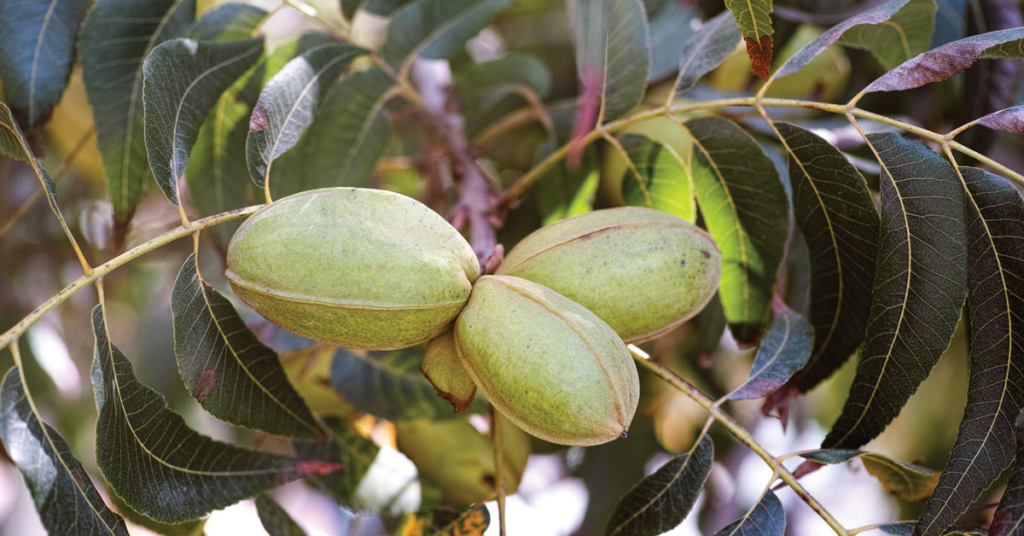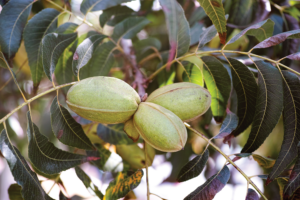
July/August 2023
2023 Pecan Crops
National Nut Grower reached out to Lenny Wells, professor of horticulture and Extension specialist for pecans at the University of Georgia, to discuss this year’s pecan harvest and postharvest considerations.
Wells’ research and Extension programs focus on practical cultural management strategies that help enhance the economic and environmental sustainability of pecan production in Georgia and the southeastern U.S.
What advice can you share with pecan growers to help protect pecan crops this year and maximize yield at harvest?

Lenny Wells (LW): At this point in the growing season we are moving into the nut sizing period, which means the nuts are at their most susceptible to pecan scab, which can colonize and grow very aggressively on developing, non-protected tissue. Therefore, from this point through mid-August, it is critical to maintain a good fungicide program on susceptible cultivars.
Rotation of Miravis Top with the Elast and Tin tank mix provide maximum protection. Sprays should be applied every two weeks even in dry weather because here in the Southeast, we get enough humidity to keep scab going on susceptible cultivars. Tighten to 10 days when receiving two or more rains following your last spray.
Also, ramp-up your irrigation run times as the season progresses. You should be at 36% of full cycle in June, 45% of full cycle in July and 100% in August and September. You can drop back to 40% or so in October, but don’t stop irrigating completely until about a week before shaking because trees need good soil moisture to facilitate shuck split.
What are the biggest pest or disease issues growers should be watchful of this season?
LW: Pecan scab is always an issue in the southeast. Also, be mindful of hickory shuckworm which needs to be treated in mid-July and again in mid-August. This is a pest that can creep up on you and you won’t realize it until harvest if not managed. And, of course, black aphids and mites will arrive in August, so be scouting for those pests regularly late in the season.
Are there any new product offerings that can help mitigate pest or disease issues that do surface?

LW: Miravis Top and Miravis Prime are two key fungicides with new chemistries over the last couple years that have been a big help in managing scab. At least one of these needs to be part of the fungicide program, particularly Miravis Top. Miravis Prime should be saved for really rainy conditions when scab pressure is at its peak on susceptible cultivars.
What plans should growers have in place to address any extreme weather challenges that could negatively impact harvest?
LW: Our weather challenges can swing one of two ways: Really wet or really dry. The El Nino year is expected to be a little more wet. This means scab control should be of primary concern through August. As we near harvest, be sure to irrigate sufficiently as dictated by rain or possibly lack thereof.
Dry conditions in August and September would lead to poor kernel filling. Dry conditions into October will prevent shuck opening. Rainy conditions during October-December would make for a very difficult harvest trying to work around rain showers and put the crop at risk for quality deterioration if growers can’t harvest in a timely manner.
Are there any new postharvest and storing options on the horizon?
LW: I see some growers beginning to invest in the Bergen field cleaners, which makes the drying process a lot easier since you get so much of that trash out before its brought into the plant for drying. This also makes bulk drying more of an option rather than the traditional method of drying in harvest wagons. The adoption of hedge pruning also seems to be producing better quality with less trash in the wagons at harvest.
What should growers do to prepare for any variables that may impact harvest
LW: Primarily, growers just need to stay on top of the weather and adjust their management accordingly, no matter which turn the weather may take. Don’t become complacent if you make it to September with things appearing in good shape. There is still time left for the crop to mature and the trees need management, particularly with regard to soil moisture in dry weather during that time. Additionally, wet or dry, growers need to harvest on-time and get the crop in as quickly as possible.
What are some best-practices in terms of storage solutions?
LW: As long as growers are able to dry the nuts and keep them in a dry warehouse after harvest, storage is not that much of an issue if the nuts are sold within a month or two of harvest. If stored more long-term, they need to make sure the nuts are dried down to 4.5% and kept at 35° F or less.







